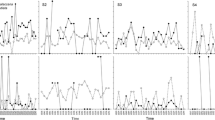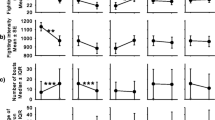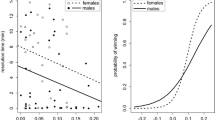Abstract
Male velvet swimming crabs [Necora puber (L.)] were observed to engage in long and vigorous agonistic interactions to gain possession of a sexually receptive female. The role of agonistic behaviour in male mate competition in this species was examined by investigating the effect of the perceived presence of sexually receptive females on interactions between males. Exposing male crabs to water conditioned by sexually receptive females resulted in prolonged interactions, with a greater incidence of potentially injurious behaviour than interactions between control crabs, exposed only to sea water. Maleconditioned water also resulted in more offensive behaviour, but these interactions were of shorter duration and not significantly different from sea water controls. Agonistic superiority was strongly correlated with contestant relative size when males were exposed to male-conditioned water or sea water, but not when exposed to female-conditioned water. Overall, the results conformed with the general predictions of game theoretic models in relation to the influence of resource value on agonistic behaviour. Crabs were more persistent and probably incurred greater fitness costs in the perceived presence of a sexually receptive female, when interactions may have been resolved on the basis of factors more closely related to actual fighting ability than the relative body sizes of contestants.
Similar content being viewed by others
References
Ameyaw-Akumfi C, Hazlett BA (1975) Sex recognition in the crayfish Procambarus clarkii. Science, NY 190:1225–1226
Arnqvist G (1992) Pre-copulatory fighting in a water strider: intersexual conflict or mate assessment? Anim Behav 43:559–567
Asakura A (1987) Population ecology of the sand-dwelling hermit crab Diogenes nitidimanus Terao. 3. Mating system. Bull mar Sci 41:282–288
Atema J, Cowan D (1986) Behavioral responses of lobsters (Homarus americanus) to conspecific odours: sex identifying molt and urine signals. J chem Ecol 12:2065–2080
Atema J, Engstrom DG (1971) Sex pheromone in the lobster, Homarus americanus. Nature, Lond 232:261–263
Bachau A (1986) Sex pheromones in Crustacea. Adv Invertebrate Reprod 4:337–343
Berrill M (1982) The life cycle of the green crab Carcinus maenas at the northern end of its range. J Crustacean Biol 2:31–39
Berrill M, Arsenault M (1982) Mating behaviour of the green shore crab, Carcinus maenas. Bull mar Sci 32:632–638
Borowsky B, Borowsky R (1987) The reproductive behaviours of the amphipod crustacean Gammarus palustris (Bousfield) and some insights into the nature of their stimuli. J exp mar Biol Ecol 107:131–144
Caldwell RL (1985) A test of individual recognition in the stomatopod Gonodactylus festae. Anim Behav 33:101–106
Choy SC (1988) Reproductive biology of Liocarcinus puber and L. holsatus (Decapoda, Brachyura, Portunidae) from the Gower Peninsula, South Wales. Pubbl Staz zool Napoli (I: Mar Ecol) 9:227–241
Christy JH (1987) Competitive mating, mate choice and mating associations of brachyuran crabs. Bull mar Sci 41:177–191
Day RW, Quinn GP (1989) Comparisons of treatments after an analysis of variance in ecology. Ecol Monogr 59:433–463
Diesel R (1988) Male-female association in the spider crab Inachus phalangium: the influence of female reproductive stage and size. J Crustacean Biol 8:63–69
Dingle H (1983) Strategies of agonistic behavior in Crustacea. In: Rebach S, Dunham DW (eds) Studies in adaptation. The behavior of higher Crustacea. Wiley Interscience, New York, pp 85–111
Dunham PJ (1988) Pheromones and behavior in Crustacea. In: Laufer H, Downer R (eds) Invertebrate endocrinology. Vol. 2. Alan R. Liss Inc, New York, pp 375–392
Edwards E (1966) Mating behaviour in the European edible crab (Cancer pagurus L.). Crustaceana 10:23–30
Elwood RW, Dick JTA (1990) The amorous Gammarus: the relationship between precopula duration and size assortative mating in G. pulex. Anim Behav 39:828–833
Emlen ST, Oring LW (1977) Ecology, sexual selection, and the evolution of mating systems. Science, NY 197:215–223
Enquist M, Leimar O (1983) Evolution of fighting behaviour: decision rules and assessment of relative strength. J theor Biol 102:387–410
Enquist M, Leimar O (1987) Evolution of fighting behaviour: the effect of variation in resource value. J theor Biol 127:187–205
Enquist M, Leimar O (1990) The evolution of fatal fighting. Anim Behav 39:1–9
Enquist M, Leimar O, Ljungberg T, Mallner Y, Segerdahl N (1990) A test of the sequential assessment game: fighting in the cichlid fish Nannacara anomala. Anim Behav 40:1–14
González Gurriarán E (1985) Reproducción de la nécora Macropipus puber (L.) (Decapoda, Brachyura) y ciclo reproductivo en la Ría de Arousa (Galicia, NW España). Boln Inst esp Oceanogr 2:10–32
Harper DGC (1991) Communication. In: Krebs JR, Davies NB (eds) Behavioural ecology. An evolutionary approach. Blackwell Scientific Publications. Oxford, pp 374–397
Hartnoll RG (1969) Mating in the Brachyura. Crustaceana 16: 161–181
Harvey PH, Bradbury JW (1991) Sexual selection. In: Krebs JR, Davies NB (eds) Behavioural ecology. An evolutionary approach. Blackwell Scientific Publications, Oxford, pp 203–233
Hazlett BA (1979) Biotic aspects of the distribution of crabs Panapeus herbstii and Mithrax sculptus. Bull mar Sci 29:576–580
Hazlett B, Bach C, Mitchell C (1977) Distributional patterns of the xanthid crab Cataleptodius floridanus (Gibbes, 1850) (Decapoda, Brachyura, Xanthidae). Crustaceana 33:316–319
Hochberg Y, Tamhane AC (1987) Multiple comparison procedures. John Wiley & Sons, New York
Huber ME (1985) Nonrandom mating with respect to mate size in the crab Trapezia (Brachyura, Xanthidae). Mar behav Physiol 12:19–32
Huntingford FA, Turner AK (1987) Animal conflict. Chapman Hall, London
Ingle RW (1980) British crabs. Oxford University Press, Oxford
Jachowski RL (1974) Agonistic behavior of the blue crab, Callinectes sapidus Rathbun. Behaviour 50:232–253
Krebs JR, Kacelnik A (1991) Decision-making. In: Krebs JR, Davies NB (eds) Behavioural ecology. An evolutionary approach. Blackwell Scientific Publications, Oxford, pp 105–136
Lee SY, Seed R (1992) Ecological implications of cheliped size in crabs: some data from Carcinus maenas and Liocarcinus holsatus. Mar Ecol Prog Ser 84:151–160
Leimar O (1988) Evolutionary analysis of animal fighting. Doctoral dissertation. University of Stockholm
Norman CP (1989) Ecology of the velvet swimming crab Liocarcinus puber (L.) (Brachyura: Portunidae). Ph.D. thesis. Polytechnic South West, Plymouth, UK
Norman CP, Jones MB (1993) Reproductive ecology of the velvet swimming crab, Necora puber (Brachyura: Portunidae), at Plymouth. J mar biol Ass UK 73:379–389
Sekkelsten GI (1988) Effect of handicap on mating success in male shore crabs Carcinus maenas. Oikos 51:131–134
Smith IP (1990) The agonistic behaviour of the velvet swimming crab, Liocarcinus puber (L.) (Brachyura, Portunidae). Ph.D. thesis. University of Glasgow
Smith IP, Huntingford FA, Atkinson RJA, Taylor AC (1994) Strategic decisions during agonistic behaviour in the velvet swimming crab, Necora puber (L.). Anim Behav 47:885–894
Smith IP, Taylor AC (1993) The energetic cost of agonistic behaviour in the velvet swimming crab, Necora (=Liocarcinus) puber (L.). Anim Behav 45:375–391
Smith LD (1992) The impact of limb autotomy on mate competition in blue crabs Callinectes sapidus Rathbun. Oecologia 89: 494–501
Sokal RR, Rohlf FJ (1981) Biometry. The principles and practice of statistics in biological research. 2nd edn. W.H. Freeman & Co., New York
Wilber DH (1986) The distribution and daily movement of stone crabs (Menippe mercenaria) in an intertidal oyster habitat on the northwest coast of Florida. Mar behav Physiol 12:279–291
Zar JH (1984) Biostatistical analysis. 2nd edn. Prentice Hall, Englewood Cliffs, New Jersey
Author information
Authors and Affiliations
Additional information
Communicated by J. Mauchline, Oban
Rights and permissions
About this article
Cite this article
Smith, I.P., Huntingford, F.A., Atkinson, R.J.A. et al. Mate competition in the velvet swimming crab Necora puber: effects of perceived resource value on male agonistic behaviour. Marine Biology 120, 579–584 (1994). https://doi.org/10.1007/BF00350078
Received:
Accepted:
Issue Date:
DOI: https://doi.org/10.1007/BF00350078




